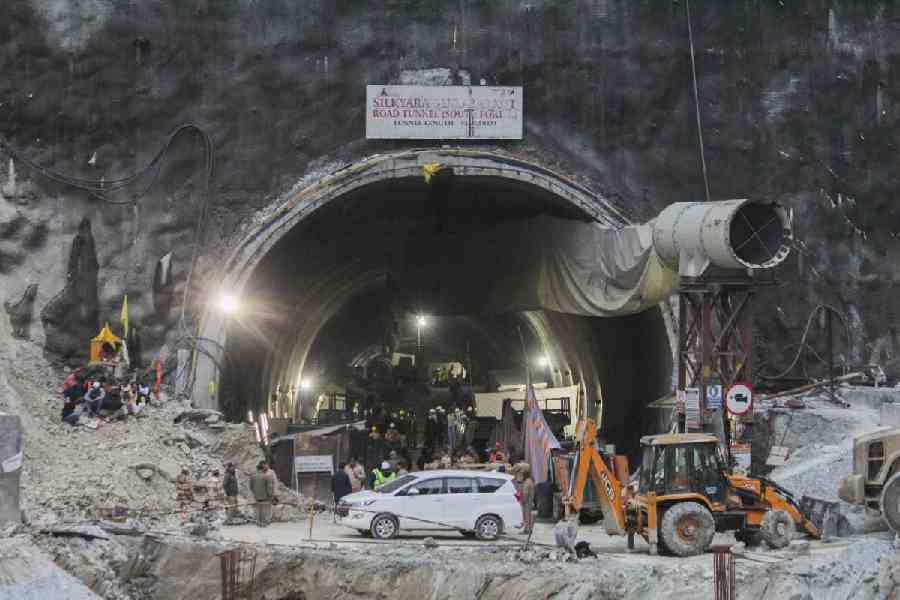After being on tenterhooks for over two weeks, the nation breathed a collective sigh of relief when the 41 workers trapped in the Uttarkashi tunnel were finally rescued. Now that the immediate task of saving the lives of the workers is behind us, it is imperative that questions are asked of the Modi government regarding the chain of failures that led to the event in the first place. And if these questions remain unadressed we may not be able to prevent such tragedies in the near future.
The most painful aspect of this tragedy is that it would not have happened if mandated safety protocols were followed. The horror that these workers had to go through was a result of the company handling the project apparently cutting corners on safety protocols with the government looking the other way. It is, therefore, vital for the Modi government to answer why it failed to ensure:
i) the tunnel had an escape passage which would have helped in emergency situations. This was against the SOP which recommends emergency exits for tunnel’s longer than 1.5km.
ii) a tunnel seismic prediction was undertaken. Such an exercise is undertaken before initiating a new phase of tunnelling work. The analysis helps engineers gauge what lies 100 meters ahead of the completed zone. Tunnel work carried out without due scientific analysis invites dangers of collapse.
iii) the use of trench cages or safe tubes to safeguard workers from potential cave-ins in unprotected parts of the cave.
iv) the presence of Hume pipes. These are concrete tubes that run through the length of the tunnel during the construction phase. These pipes, meant for rescue in case of a collapse, were removed even when a significant portion of the work was left to be completed.
v) the preparation and implementation of detailed, project-specific SOPs regarding the tunnel work.
Series of lapses
The series of lapses reveal a dark reality: that the government cares more for the profits of construction companies than for the lives of workers.
The other painful aspect of the tragedy is its direct correlation to the manner in which successive governments have betrayed a lack of seriousness about environmental concerns, approaching them from the prism of “obstacles to development”. This was a tragedy waiting to happen, given the way environmental norms and best practices were ignored. Consider these:
i) a Supreme Court-appointed high-powered committee had recommended building a narrow tunnel of 7-8 meters width, but the government ignored it, leading to excessive use of explosives, thereby increasing risk of a collapse.
ii) experts have pointed out that a weak patch of rock was not identified during the digging process, and the fragile rock formation was not taken into consideration.
iii) no comprehensive environment impact assessment (EIA) was undertaken as the government classified the Char Dham project not as a single project requiring comprehensive EIA but a series of 53 small projects that did not require a comprehensive EIA.
iv) Several sections of the highway being built under the project pass through eco-sensitive zones. How has this been allowed? Either the government changed the land use norms of the area or falsely declared that eco-sensitive zones weren’t in the route.
A dangerous pattern
Worse still, the Uttarkashi tragedy is not an isolated incident. It is a part of a dangerous pattern. This year itself India has seen a series of environmental disasters like the Joshimath subsidence, the Himachal Pradesh landslides and the Sikkim dam burst. All these were mega disasters that have led to loss of lives, damage to infrastructure and livelihood opportunities, and disrupted life in these regions for prolonged periods.
The common link is that these have been caused or aggravated by the government giving the short shrift to environmental norms even as it goes about expanding highways or contracting mega projects in eco-sensitive zones which then make these regions more prone to floods and landslides (the same highways are the first to be washed away and collapse). Also, indiscriminate dumping of construction debris causes rivers to change course and increases risk of floods.
Tragedy after tragedy
The Uttarkashi incident reveals a third disturbing trend of mega projects being undertaken under the Modi government’s watch: these are repeatedly beset with tragedies. From the Morbi bridge collapse that killed 135 people to the death of 20 people on the Samruddhi Expressway (incidentally, the company involved in the Uttarkashi tunnel work was involved here too), to the Bundelkhand Expressway developing cracks five days after inauguration, to the Delhi-Mumbai Expressway bridge getting depressed within a month of inauguration by the Prime Minister and the Hatkeshwar flyover bridge in Ahmedabad being rendered unusable within five years of being built, the trend of poorly implemented projects whose quality is compromised is unmistakable.
The government’s repeated failure of project oversight is made worse by lack of any stringent action even after tragedy strikes. There is no accountability. The Uttarkashi tunnel collapse exemplifies this _ the same portion of the tunnel had collapsed in 2019 too. And no lessons were learnt. Hence, the Char Dham project tragedy is a wake-up call, a call for all of us to start holding the government to account for its disregard for the safety of ordinary Indians, for its harmful disregard of environmental norms and for its rampant mismanagement of mega projects. Hopefully, it is a call we respond to before any more lives are lost.
Priyanka Kakkar is Chief National Spokesperson of AAP. Opinions expressed in this article are her own.











